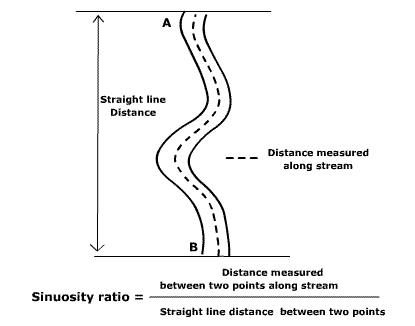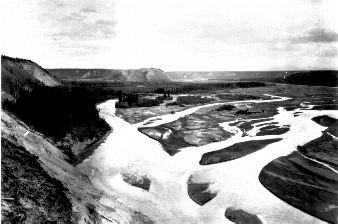Channel TypesThere are three basic types of channels, straight, meandering and braided. Describing a channel by one of the aforementioned terms does not mean that the entire channel is straight or otherwise. It simply means that some portion of the channel can be described in such a way. In fact, portions of a stream may be straight, some meandering and others braided.
Describing a channel as a straight channel seems
pretty obvious, though rarely is a channel perfectly straight
in nature. A meandering channel
is one that takes twists and turns over its length.
A braided channel
Pools and RifflesWe often find a regular sequence of shallow riffles and deeper pools in stream channels, the cause of which is still not well understood. The spacing of the riffle-pool sequence is related to the width of the stream. Riffle-pool sequences usually are 5-7 times the width of the channel. Laboratory experiments with artificial channels in noncohesive sand or silt show that riffle and pool sequences in straight channels tend to evolve into meanders. When this happens, a pool becomes a site for a laterally migrating meander. The stream thalweg meanders back and forth between pools, moving toward the outer bank of each successive curve. Erosion is therefore concentrated at the outside banks where the flow is deepest and stream velocity accelerates around meander.
Assess your basic understanding of the preceding material by "Looking Back at the Stream System, Channel Geometry, Types and Flow" or continue reading. |
 Figure 18.25 The sinuosity ratio
Figure 18.25 The sinuosity ratio Figure 18.26 Braided river at junction of Gakona and Copper River, Alaska
Figure 18.26 Braided river at junction of Gakona and Copper River, Alaska